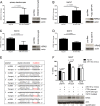miR-181a decelerates proliferation in cutaneous squamous cell carcinoma by targeting the proto-oncogene KRAS
- PMID: 28931048
- PMCID: PMC5607211
- DOI: 10.1371/journal.pone.0185028
miR-181a decelerates proliferation in cutaneous squamous cell carcinoma by targeting the proto-oncogene KRAS
Abstract
Cutaneous squamous cell carcinoma (SCC) is the second most common human skin cancer with a rapidly increasing incidence among the Caucasian population. Among the many regulators, responsible for cancer progression and growth, microRNAs (miRNA) are generally accepted as key players by now. In our current study we found that microRNA-181a (miR-181a) shows low abundance in SCC compared to normal epidermal skin. In vitro, miRNA downregulation in normal primary keratinocytes induced increased proliferation, while in vivo miR-181a downregulation in HaCaT normal keratinocytes showed tumor-like growth increase up to 50%. Inversely, upregulation of these miRNAs in cancer cells lead to reduced cellular proliferation and induction of apoptosis in vitro. An in vivo therapeutic model with induced miR-181a expression in SCC13 cancer cells reduced tumor formation in mice by 80%. Modulation of miR-181a levels showed an inverse correlation with the proto-oncogene KRAS both on mRNA and protein level by direct interaction. Knockdown of KRAS mimicked the anti-proliferative effects of miR-181a overexpression in patient-derived SCC cells and abolished the enhanced viability of HaCaT cells following miR-181a knockdown. Furthermore, phospho-ERK levels correlated with KRAS levels, suggesting that the observed effects were mediated via the MAPK signaling pathway. miR-181a seemed regulated during keratinocyte differentiation probably in order to amplify the tumor suppressive character of differentiation. Taken together, miR-181a plays a crucial tumor suppressive role in SCC by targeting KRAS and could be a promising candidate for a miRNA based therapy.
Conflict of interest statement
Figures




Similar articles
-
Targeting the RAS/MAPK pathway with miR-181a in acute myeloid leukemia.Oncotarget. 2016 Sep 13;7(37):59273-59286. doi: 10.18632/oncotarget.11150. Oncotarget. 2016. PMID: 27517749 Free PMC article.
-
miR-181a shows tumor suppressive effect against oral squamous cell carcinoma cells by downregulating K-ras.Biochem Biophys Res Commun. 2011 Jan 28;404(4):896-902. doi: 10.1016/j.bbrc.2010.12.055. Epub 2010 Dec 15. Biochem Biophys Res Commun. 2011. PMID: 21167132
-
MicroRNA-181a enhances the chemoresistance of human cervical squamous cell carcinoma to cisplatin by targeting PRKCD.Exp Cell Res. 2014 Jan 1;320(1):12-20. doi: 10.1016/j.yexcr.2013.10.014. Epub 2013 Oct 31. Exp Cell Res. 2014. PMID: 24183997
-
MicroRNA Dysregulation in Cutaneous Squamous Cell Carcinoma.Int J Mol Sci. 2019 May 2;20(9):2181. doi: 10.3390/ijms20092181. Int J Mol Sci. 2019. PMID: 31052530 Free PMC article. Review.
-
miR-181a: regulatory roles, cancer-associated signaling pathway disruptions, and therapeutic potential.Expert Opin Ther Targets. 2024 Dec;28(12):1061-1091. doi: 10.1080/14728222.2024.2433687. Epub 2024 Dec 8. Expert Opin Ther Targets. 2024. PMID: 39648331 Free PMC article. Review.
Cited by
-
Deciphering the Molecular Landscape of Cutaneous Squamous Cell Carcinoma for Better Diagnosis and Treatment.J Clin Med. 2020 Jul 14;9(7):2228. doi: 10.3390/jcm9072228. J Clin Med. 2020. PMID: 32674318 Free PMC article. Review.
-
A MiR181/Sirtuin1 regulatory circuit modulates drug response in biliary cancers.Clin Exp Med. 2024 Apr 10;24(1):74. doi: 10.1007/s10238-024-01332-0. Clin Exp Med. 2024. PMID: 38598008 Free PMC article.
-
miRNome and Proteome Profiling of Human Keratinocytes and Adipose Derived Stem Cells Proposed miRNA-Mediated Regulations of Epidermal Growth Factor and Interleukin 1-Alpha.Int J Mol Sci. 2023 Mar 4;24(5):4956. doi: 10.3390/ijms24054956. Int J Mol Sci. 2023. PMID: 36902387 Free PMC article.
-
Oh, the Mutations You'll Acquire! A Systematic Overview of Cutaneous Squamous Cell Carcinoma.Cell Physiol Biochem. 2021 Sep 22;55(S2):89-119. doi: 10.33594/000000433. Cell Physiol Biochem. 2021. PMID: 34553848 Free PMC article. Review.
-
Functional Specificity of the Members of the Sos Family of Ras-GEF Activators: Novel Role of Sos2 in Control of Epidermal Stem Cell Homeostasis.Cancers (Basel). 2021 Apr 29;13(9):2152. doi: 10.3390/cancers13092152. Cancers (Basel). 2021. PMID: 33946974 Free PMC article.
References
-
- Hofbauer GF, Bouwes Bavinck JN, Euvrard S. Organ transplantation and skin cancer: basic problems and new perspectives. Experimental dermatology. 2010;19(6):473–82. Epub 2010/05/21. doi: 10.1111/j.1600-0625.2010.01086.x . - DOI - PubMed
-
- Lohmann CM, Solomon AR. Clinicopathologic variants of cutaneous squamous cell carcinoma. Advances in anatomic pathology. 2001;8(1):27–36. Epub 2001/01/11. . - PubMed
-
- Ratushny V, Gober MD, Hick R, Ridky TW, Seykora JT. From keratinocyte to cancer: the pathogenesis and modeling of cutaneous squamous cell carcinoma. The Journal of clinical investigation. 2012;122(2):464–72. Epub 2012/02/02. doi: 10.1172/JCI57415 ; PubMed Central PMCID: PMCPMC3266779. - DOI - PMC - PubMed
-
- Brash DE, Rudolph JA, Simon JA, Lin A, McKenna GJ, Baden HP, et al. A role for sunlight in skin cancer: UV-induced p53 mutations in squamous cell carcinoma. Proceedings of the National Academy of Sciences of the United States of America. 1991;88(22):10124–8. Epub 1991/11/15. ; PubMed Central PMCID: PMCPMC52880. - PMC - PubMed
-
- Euvrard S, Kanitakis J, Claudy A. Skin cancers after organ transplantation. The New England journal of medicine. 2003;348(17):1681–91. Epub 2003/04/25. doi: 10.1056/NEJMra022137 . - DOI - PubMed
Publication types
MeSH terms
Substances
LinkOut - more resources
Full Text Sources
Other Literature Sources
Medical
Molecular Biology Databases
Research Materials
Miscellaneous

